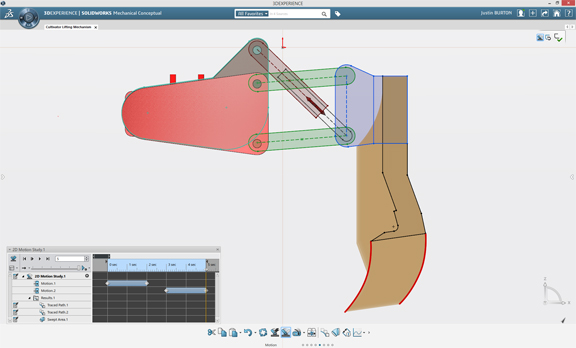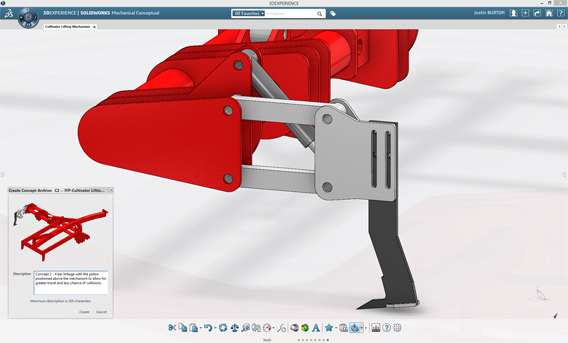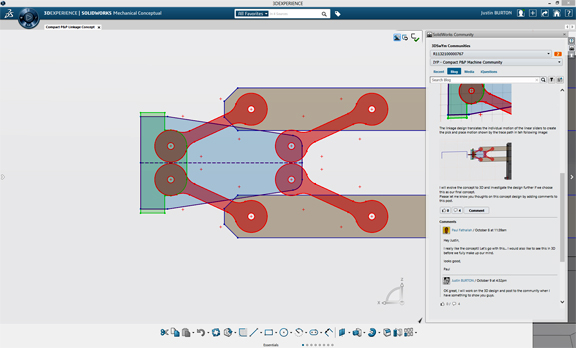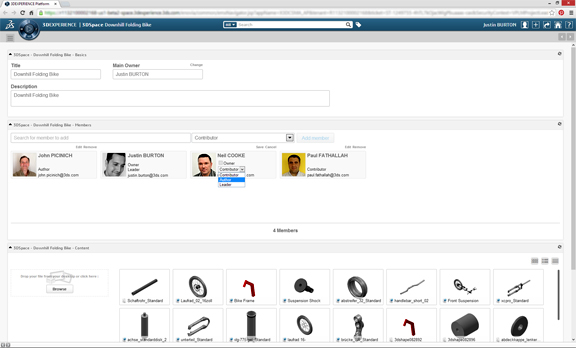Latest News
January 29, 2014
Along the San Diego Bay and the popular Gaslamp Quarter, the week began with a cloudy sky. Inside the San Diego Convention Center’s 90,000 sq. ft. twin-ballroom theater, SolidWorks CEO Bertrand Sicot kicked off the day with a warm welcome to the 6,000-plus customers who’d flown or driven into town for the annual user conference, SolidWorks World 2014.
Sicot said, “Our goal at SolidWorks World is to inspire you—to be more creative, to be more productive, to be more passionate. We believe inspired people create inspired design.”
Most attendees knew this year they might bear witness to the birth of a brand new product. The industry press had tipped them off a full year ago with tidbits about Mechanical Conceptual. But the company had another surprise in store.
Mechanical Conceptual (MC) has a cousin called Industrial Conceptual (IC). Whereas MC is designed to let you quickly sketch, animate, and sculpt classic mechanical components, IC is expected to let you produce organic shapes and complex surfaces with a minimum learning curve.
In a departure from the traditional SolidWorks licensing model, MC goes on sale in April under subscription for $249 a month. IC is expected to enter Lighthouse phase (the post-Beta phase) with select customers this summer, with no date set yet for public release.
Thus, with two new products in its portfolio and a decisive step toward on-demand licensing, SolidWorks marks the beginning of a new era.
More search, less history: Aaron Kelly, the company’s VP of user experience and portfolio management, revealed a version of MC that was in all appearance ready to go. Feedback from the Lighthouse customers who shared the stage with him was positive and enthusiastic. On April 2, MC officially goes on subscription. (Why the second? I’m guessing no sales team would want to launch a product on the mischief-prone April Fool’s day.)
Those familiar with SolidWorks—and other history-based mechanical CAD programs, for that matter—will be struck by the absence of a history-tree in MC’s interface. Kelly said, “[The feature history] is still there, but it’s not in your face. You don’t need to go there to make changes.”
The modeling operations occur mostly through dragging and pushing faces. Kelly doesn’t object to the description as “direct editing,” but added, “We took a different approach. What we really wanted to deliver was something instinctive. It’s a natural workflow, without the CAD overhead that requires learning the CAD language. If you want something to change size, you can make it happen. You shouldn’t have to invoke a CAD command.”
Sicot revealed that MC is built on two crucial Dassault Systemes technology components: Convergence Geometric Modeler (CGM) as its modeler; Constraint Design Solver (CDS) as its solver. CGM is also the base technology for Dassault Systemes’ higher end product CATIA.
MC has a single modeling environment for sketching, simulation (in 2D sketches), component design, and assembly design. At every stage, the product anticipates the necessary input and offers a dialog box; thus, the onscreen menus are kept at a minimum. The enterprise search engine Exalead, a Dassault Systemes product, appears as an integrated search box to find and locate files and documents.
The social pane adds Facebook-like tools for locating potential collaborators, monitoring discussion threads and activity feeds related to certain files. The program also lets you import community content from 3D Content Central and other sources.
Half in cloud, half on desktop: With a thick client augmented by online collaboration and data storage functions, MC straddles bot the desktop and the cloud. Cloud storage is an inherent part of the product because it’s the best way to facilitate Google doc-style simultaneous viewing and editing among multiple project team members, Kelly pointed out. (Jonathan Tippett from eatART Foundation, a keynote speaker at the conference, remarked that MC was “like the Google doc for engineering.”)
“I had my own concerns,” Kelly admitted. “Would the customers say, ‘I don’t know if I want my data in the cloud’? But when we spoke to our Lighthouse customers, we found out they didn’t care.”
Some Dassault Systemes products like CATIA can be installed in the private cloud, in a client-server setup behind the customer’s firewalls. MC, by contrast, is explicitly designed for a multi-tenant, public cloud setup. It currently does not have a private cloud setup, according to Kelly.
Subscription as the shape of things to come: In the initial launch, MC subscription requires at least a year’s commitment, Kelly said. At $249 a month, that works out to $2,988 a year. But the requirement may relax over time, leading to quarterly and month-to-month subscriptions, according to Kelly.
In his interview with me, Sicot said, “The Lighthouse customers told us [MC] is not a tool they’ll use only one month or two. They’ll do concepts all year long, so they’re already committed to a yearly lease. Not an issue for them. But maybe we’ll see other smaller customers and independent designers who’re not like that. We’re all going to learn from this. And we’ll adjust if needed.”
A handful of SolidWorks rivals—Siemens PLM Software and Autodesk, most notably—have begun exploring the rental model. If the MC subscription proves successful and popular, Sicot may consider a similar plan for SolidWorks.
“Why not? I’m very open.” said Sicot. “Today you can buy SolidWorks or lease it. Basically you pay monthly, depending on your financial arrangement. But there are customers who say, ‘Today, my business visibility is not so good.’ Later, they may say, ‘Now I need more than the ten seats I have. But six months later I won’t need them.’ They need flexibility. We haven’t decided on [SolidWorks subscription], but it’s something on the table.”
MC will be distributed through all Dassault Systemes channels, Kelly said.
For the industrial artist: The teaser of Industrial Conceptual (IC) presented onstage shows a product that lets you poke, pinch, and push on objects to quickly sculpt shapes typically associated with 3D modelers used by film and game industries. (Think shapes possible in Autodesk Alias or Maya.) No release date is published yet, but Kelly said the product will be deployed at select customer sites in production environment this summer, as a Lighthouse program.
Forging a new path: Devout SolidWorks fans shouldn’t worry that R&D efforts for the two new products might detract the company’s dedication to its classic CAD brand, Sicot assured. “The proof is in the pudding,” he said. “Every year, we deliver a robust release.” Sicot also revealed he’d added R&D staff in the company to reflect the increased effort. “We have two teams now. One dedicated to the existing product line. Another working in parallel on the new products.”
The conceptual phase, Sicot felt, has always been a bit neglected. Since it’s a phase characterized by what Sicot called “unstructured collaboration” and exploration of different ideas (many of which might be abandoned later), a modeling program with a low learning curve that accommodates quick geometry changes is ideal. Parametric CAD programs meant for detailed modeling have proven to be heavy-handed for concept development.
Direct modelers like SpaceClaim, Solid Edge with Synchronous Technology, Autodesk Inventor Fusion, and PTC Creo have, each in their own way, encroached on this territory. MC have not yet been market-tested, but it appears to have the right attributes for concept modeling. If MC offers seamless—and problem-free—data exchange between itself and SolidWorks and other Dassault Systemes products, its appeal as a concept modeler increases many folds. At about $3,000 a year, MC’s debut cost is almost the same as a detailed CAD program. For some, it may be a reasonable investment. But for smaller design shops and manufacturers with inconsistent workloads and projects, MC is an attractive proposition if it comes with the option to subscribe or cancel at any time.
A brief history: The first public mention of MC was back in September 2012, during the introduction of SolidWorks 2013 (SW2013) to the press. Midway into the roundup of new features in SW2013, Sicot described an unnamed product in development, aimed at the early design phase that classic CAD programs couldn’t adequately address. “It’s not a replacement for SolidWorks; it’s a complimentary product,” he emphasized.
But the genesis of MC may go back even further. Four years ago at SolidWorks World 2010, before Sicot took the helm of SolidWorks, his predecessor Jeff Ray previewed a series of technologies under development. Attendees saw, among other things, SolidWorks running on multi-touch tablets, push-pull editing tools, and cloud-hosted modeling sessions. The revelations prompted strong reactions among some users who, for one reason or another, preferred to keep their CAD strictly desktop.
With MC, SolidWorks has packaged a sensible mix of cloud and desktop features in an intuitive interface. Judging from the demonstration onstage this week, it fulfills its promise to be conceptual, intuitive, connected, and social. In my view, it’s also a realization of the visions shared by the company in 2010.
By taking a leap into the cloud and the subscription model, SolidWorks takes considerable risk. But risk is also an inherent part of inspiration and creativity.
Subscribe to our FREE magazine, FREE email newsletters or both!
Latest News
About the Author
Kenneth Wong is Digital Engineering’s resident blogger and senior editor. Email him at [email protected] or share your thoughts on this article at digitaleng.news/facebook.
Follow DE









